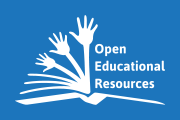Blended Learning Course for Certified OER Practitioners
Contents
General instructions
If you have any questions related to the course, please consult your facilitators directly:
mailto:ebba.ossiannilsson@oer-services.com
mailto:andreas.link@oer-services.com
In case you need some technical support, please send an email to:
mailto:admin@learning-agency.net
If you want to participate in one of the Blended Learning courses, please send an email to mailto:secretariat@oer-services.com
The course for Certified OER Practitioners is also displayed at another "workbench" - which we keep also up to date. When there is a new version of the course, we upload it here.
Licence
Written resources (story, content, activity) by Ebba Ossiannilsson and Rolf Reinhardt on this site is licensed under CC-BY-SA 3.0 unported.
The course has been designed and reviewed by an International Committee of leading OER actors. The discussions are publicly viewable here: http://international-cv.net/group/view.php?id=30
Purpose
It is our objective to promote and facilitate the widespread of OER worldwide in educational organisations. We believe that skilled, motivated and connected practitioners are key to reach this vision.
- The course is building up on the existing materials for self-study, as well as the previously and currently conducted research projects on OER - however is emphasizing on the needs of a “normal” practitioner.
- The course is complementing these initiatives by focusing on the interrelation between course participants and organisational stakeholders.
The big YOU
Current practices in relation to potential practices. (3 hours)
Story
Sophie is exhausted. She just graduated from university and was now assigned to teach a class in the local secondary school. Yes, she learned a lot during her studies, but she didn't expect that it is so much work to prepare just one hour of teaching in the classroom. Sophie spent already two hours with preparing one hour in class!Sophie started with a big portion of idealism in her new job. She wants to do it better then her own teachers who she still remembers very well:
(Teacher stories will consist of the participant's cases)
- Kevin: Used very old material and did always the same since 25 years. He was even more bored of himself than his students, but he drilled quite well and most of the students got good notes.
- Catherine: Followed always her intuition and was a friend of anthroposophic and interactive approaches. Students developed a horror of dancing their names but they liked the creative atmosphere.
- Samuel: Was convinced of his geniousity and based his classes always on long monologues. The students hardly could identify any structure but they could count on that Mohamed indeed new almost every answer.
- Maya: Was addicted to social media and wanted to introduce her love for Facebook also to the class. Every material that she distributed, she somehow found in the internet. The students were not sure about her taste and the quality of the resources - but they liked the Facebook approach.
Just one week before, the local computer shop has donated three more computers for her class. Now, she has 5 computers for 20 students - and Sophie would love to use the internet with her class since she knows that the students enjoy learning with the computer.
But Sophie is still not experienced and needs support to prepare her class. Can you help her? Concrete, she needs answers on the following questions:
- What is important to consider when using material from the internet for the course preparation?
- What can be possible practices that Sophie can use? (Possibility to feed in the current Good Practices of the course participants)
- How can she identify quickly high quality learning material?
Information
More and more teachers are using ICT to engage their students in the classroom. In some parts of the world, the use of a computer is often the only possibility to have access to educational resources. This is why a lot of international projects e.g. OLPC but also local initiatives (i.e. Corporate Citizenship).Many studies, e.g. from Becta or the European Schoolnet have shown a positive impact of ICT integration in schools - for both learner and teacher.
Also the software and hardware industry is keen on elaborating this field: More and more publisher are offering eLearning courses and platforms for teachers and students. The problem of these solutions: They are often too expensive and it is difficult to implement such systems only on a practitioner level.
However, there are many excellent alternatives out there! Do you know already some? Please engage yourself in the activity and share your knowledge.
Activity
- Split in small groups (2-3 people).
- Analyse the cases of Sophie's teachers and compare them with your own experiences.
- List "Do's" and "Don'ts" (related to yourself and your understanding of OER) in the forum.
- Join a common Skype meeting to wrap-up the discussions.
The big WHAT?
The definition of OER and related terminology. (2 hours)
Story
Sophie has now heard about something called "OER" which could ease her life and engage her students. She is very keen on knowing more about this topic, thus she decides to send an email to an old friend of her: Bob. He is working in an IT company and should now everything about this promising solution.However, when Sophie receives the answer of Bob, she is totally confused! So many unkown words and acronyms! The letter looks like this:
_____________________________
Hi Sophie,
thx for asking and welcome in the EFA family!
OER is normally CC licensed because of the IPR issue. It can be BY attribution or restricted to SA, ND, NC etc. But OER implementation needs a suitable OEP or even an OEC!
If you want to create OER, you need a CMS or a simple blog. Don't worry, they have already a WYSIWYG for those who can't deal with HTML. But most of the OER crowd is using a wiki. It is even possible to create OER with an authorware.
Well, it depends on the size of your chunks or LOMs and the granularity of your course.
IMHO, you use only OSS when creating or modifying OER. Here is a link: http://bit.ly/KSzFbL
OER doesn't mean no costs, but these can be epsilon. ROFL Tip: Try to get the lurkers from outside involved and keep yourself informed on recent developments by RSS. Well, anyway keep Murphy's law always in mind! And if you ever launch a project, get sure you have a good POA and the name is YABA-compatible! ;-)
If you want to talk, you find me on Skype or Mumble.
Cheers!
Bob
_____________________________
Information
The main problem for a "newbie" when entering innovative and i.e. technical areas is the terminology. There are several reasons: Some technical experts tend to strengthen a certain feeling of belonging to a group of pioneers. But often, there is simply also a need to create a new terminology for developments.Knowing the terminology code, will enable people to learn much faster, because they are able to identify valuable resources in the internet through various Search Engines like Google.
There is an OER Glossary, done by the Wikieducator team, with useful explanations.
It is nearly impossible to know everything in a newly developed terminology. That's why it is first of all crucial to use Google Search properly. Josh Catone has prepared a useful guideline in his infographic.
Activity
- Split into groups à 2 people.
- Identify reliable resources in the web which help you to explain the explain the used terminology in Bob's letter (every team gets vocabulary assigned). Try to relate official definitions from the Wiki and how it relate to your own context.
- Try to find practical examples or metaphors out of your own life that could explain the terminology.
- Re-grouping in teams à 3 people. The first explains the meaning to the second, then the second explains what he understood to the third who is the expert for this specific terminology.
The big WHY?
The potential of OER in society and educational organisations: to reason the OER implementation to different organisational stakeholders. (1 hours)
Story
Thanks to your support, Sophie has meanwhile understood the meaning of "OER" and relevant terminology. She has become also very curious to make use of this promising recommendation of Bob. In particular, she would like to engage her students more and to decrease the time that she spends for the preparation.However, Sophie thinks about having some more computers in her classroom. It would be ideal to have 7 instead of 5 computers for the practices that she is envisaging. Two new computers require some budget and thus an approval from the dean, Stephen, and the council. They need to be convinced of the usefulness of such an investment.
The majority of the students will be surely very happy with doing something completely new. But some of the students and their parents could be opposed to the usage of new technology. In particular some religious muslims are not even using Facebook or other social media infrastructure - they could be also against exposing their material in the internet.
Sophie is a bit insecure and she needs some help to convince as well the dean, but also the opposed students and parents.
Information
Interestingly, the promotion of OER was done first by policy bodies, namely the UNESCO, starting in 2002. In a later stage, OER was used and discussed mainly among academics in funded projects. One of the reasons to finance such projects was seen in visions such as free access to educational material which would benefit mainly developing countries.On the other side, there are a variety of advantages for practitioners to get engaged into the OER movement, e.g. to get ideas for lessons or coursework, supplement them and improving teaching methods. Also the connection between OER creators and users is playing an important role according to a OER Commons survey.
Now, it is up to you: What reasons can you identify to justify the introduction to OER to the dean and to the students?
Activity
- Participate in the forum's discussions and try to convince the dean and a representative of the worried students to implement OER.
Please use the specific threads for the individual debates.
The big HOW (1/2)?
To use, reuse, create, remix and license OER. (4 hours)
Story
Thanks to your help, the dean and the students are both convinced of using open learning practices in Sophie's courses. She even got 2 more computers for her classroom. Sophie is happy: Finally she can start.The first challenge is to find high quality educational resources. Sophie is totally overwhelmed from the size of repositories such as Connexions or Merlot. Finally, Sophie finds out about the Khan Academy and decides to send out the links to the videos already before the course unit.
By this, her students already get a glimpse of the content and can already practice. During the class, Sophie is now creating new learning resources out of existing one.
Bob has set up a wiki for Sophie which shall serve as a common repository and preparation for the exam. On the wiki, the students shall elaborate localized content and practices. The advantage: Sophie can observe who contributed to which extend to the wiki and if needed improve the material.
In addition, every student was encourages to create an individual blog with Wordpress for a personal learning diary and ePortfolio.
So far so good, but now the most important part starts: What resources can be used and under which conditions? How can the resources be modified? What possibilities are existing to publish the resources to a broader audience?
Sophie needs your help.
Content
There are already many resources, manuals and tutorials published on various OER related topics. One of the best collections are the OLCOS tutorials in EN/DE/ES.In addition, there are also several self-study courses on OER like for example the OER Workshop.
In the course example, we focus on two ways to author OER:
- Wikis: The advantage of a wiki is the collaborative character. It is relatively easy to contribute to a wiki (WYSIWYG editor). The most well-known example is Wikipedia. There are already a lot of hosted wikis available. For educational purposes, the Wikieducator can be seen as a good choice.
- Blogs: Meanwhile blogs are widely used to author and publish OER. There are some large providers such as Wordpress and Blogger (formally Blogspot).
The key to make a media content to an OER is the licensing. There are many types of licenses (see also the OLCOS tutorial or the OER Workshop), but mainly a Creative Commons (CC) license is applied. When choosing a license, you can use the License Selector of Creative Commons.
When thinking about how and where to publish OER, the Wikieducator provides a comprehensive guideline on Publishing OER.
For all of those who want to dig deeper into the matter of "re-use", the Commonwealth of Learning just published A report on the Re-use and Adaptation of Open Educational Resources (OER).
Activity
- Identify at least two suitable open educational resources related to a course of your choice. Please reason in the forum how you have identified the resource and why you think that the material is of high quality. Please also distinguish between searching for definitions (The Big What) and searching for OER.
- Combine the two (or more) open educational resources in one document (format: DOC or ODT) and upload them.
- After the approval, create a wiki site using the formatting options of mediawiki.
- Select an open content licensing approach and reason your decision related to legal aspects in the forum.
- Set up a Wordpress blog and reflect upon the wiki OER of one of your peers.
The big HOW (2/2)?
To sustain and develop the maturity level of OE resources, practices and cultures. (2 hours)
Story
Sophie presents the wiki and the blog entries of the students proudly to the dean, Stephen. He directly sees a potential to widespread Sophie's innovative practice throughout the own faculty.Concretely, Stephen thinks also about his own situation: Due to budget cuts of the government, he has much less money to spend then in the years before. Stephen is convinced that if his school could do some public relations activities by producing and publishing OER, there might be also more pupils from the region attracted to attend his school - or even a local company could sponsor such activities.
What is more, Stephen has heard of the possibility to participate in funded projects with innovative teaching and learning practices. Sophie's work could really prepare the way for such channels.
But Stephen is not totally sure. He would like to check the quality of Sophie's resources and processes first by an external Quality Assurance (QA) expert. He calls his colleague Margrete, who is working for an international quality accreditation body to attend Sophie's class and evaluate her performance.
Sophie is first a bit afraid since she doesn't know how she could prepare the visit of Margrete and reason that there is not only a higher engagement of her students - but also a higher quality of common learning resources and processes.
Can you help Sophie?
Content
Quality is defined as a fitness for purpose (Wikipedia), which relates to certain subjective perspectives on the purpose. In a recent press release, epprobate asks the question "Is eLearning quality in the eye of the beholder?" and reflects upon the view on eLearning resp. OER quality from different perspectives.For everyone who is interested to learn more in detail about the evaluation of resources (courseware), the final outcomes of epprobate initiative, a publicly available (CC-BY-SA) quality grid might be very useful.
Whereas epprobate focuses on the courseware (learning resource) only, the CC-BY licensed eLearning Maturity Model (eMM) which has been developed by Stephen Marshall in New Zealand, can be used to evaluate and improve also courses and organisational strategies. Over the years, the eMM has been further developed and there is a good documentation available.
Quality development can be interlinked with financial sustainability in the sense that a high and evidence-based or at least proven quality level attracts more learners. The most well-known examples of institutional OER producers, such as the MITx or the Open University UK, are providing OER as a part of their marketing strategy, to either attract more students (OUUK) or to strengthen the own reputation in general.
Another link to quality development and OER is seen in the possibility of public feedback on resources. For example, the Vytautas Magnus University is recording all the lectures of the teaching staff. At first instance, it was difficult to convince the teachers of this approach, but now the lectures are of higher quality.
There are different views on the financial sustainability of OER. Some are of the opinion that teachers, since they are paid by the state, should anyway publish their educational resources openly. States like e.g. Brazil, have even launched a OER policy initiative to promote the licencing with CC.
One of the core areas of earning money with the OER production - at least at the current stage - is the application for public funding. Just recently, the US Government has announced to invest 2 Billion Dollar for the OER development in Community Colleges. Also the European Commission in Brussels funds OER within various European project calls.
Last but not least, there is also a possibility to attract e.g. local sponsors. In contradiction to classic advertising, such a marketing activity aims for public relations or corporate citizenship activities.
David Wiley and Justin Johansen have described a Sustainable Model for OpenCourseWare Development in detail for universities.
Last but not least, it has to be emphasized that a congruent usage of OER dramatically reduces the spending for textbooks. The State of California in the USA is currently undertaking a promising project called California Open Source Textbooks Project.
Activity
- Select an OER of your choice and do an evaluation in line with the epprobate quality grid.
- Find a peer and present your findings (10 min each presentation). The peer shall ask critical questions (5 min). Afterwards, post your insights in the forum.
- Identify a benchmark for OER integration in an educational organisation (you might also browse the OPAL Clearinghouse.
- Review the example with the eMM quality grid (if you can't evaluate parts, simply skip them).
- Discuss the organisational practices with one of the other students.
- Document your insights in the forum.
The big WHO?
The identification and the involvement of internal and external stakeholders: to network on small and large scale. (2 hours)
Story
After having read the report of the QA agent and realizing the potential of using OER for the organisation, Stephen wants to widespread OER in his organisation.Sophie is therefore assigned "OER Change Agent", and she has to convince and teach other relevant stakeholders. Sophie feels quite overwhelmed as she has never done an activity like this before. So, she decides to browse the web and identify a real "OER Expert" who could support her.
After searching some time, she sees a picture of a guy who seems to be very nice - and handsome. His name is Bill and he runs a personal blog on OER implementation in schools. Obviously, he is also a teacher like Sophie, but with far more knowledge and experiences in the OER implementation.
Sophie decides to contact him directly. After only one hour, she receives his answer:
________________________
Dear Sophie,
thank you for your email and your questions. What a great project you have in front of you! I am honored to contribute and to help you where I can.
But I also have to warn you: Organisational change, in particular in educational institutions, is very difficult. I had to learn this myself that the rusty structures of our system are hardly allowing you any kind of innovation. So, you need to have a high frustration-tolerance first.
What I have learned is that it is good to have a big vision, but that it is necessary to achieve it in small steps. In fact, you have to realize first that you can't do it alone!
Your success is based on personal networks with the relevant stakeholders, both inside and outside of your institution. Now, you have your boss behind you, which is really important - but there are so many other people you need inside your school. You also need to take into consideration the resistance of key players. If this happens, your project might be lost and it will be even more difficult to start again.
Externally, it is useful to join a Community of Practice on OER Implementation. Best is if this Community is rather small and you have personal contact to each other.
Please count on my support - whatever you might need. Since you live not so far away, maybe we can also go for dinner together one day and discuss further steps in person...
Best wishes,
Bill
________________________
Sophie has to smile. It feels good to be not alone with such a huge project and to be able to count on the support of a community. And in particular Bill seems to be very nice. She definitely will meet him for dinner.
Still, Sophie needs to define the important stakeholders. Can you help her?
Content
Depending on the size of the implementation, there can be quite a lot of stakeholders. Some of the most important once, are listed here:
| Role | Important for | Convinced by |
| External OER expert community | Latest news and development related to OER | Normally, it is enough to follow them. Sometimes, it makes sense to invite them as motivational speaker for kick-off events etc. |
| External OER practitioners | Practical problem solving, motivation | Personal connection, sharing the same spirit |
| Dean and Management Board or Council of faculty | Financial and time support, setting-up binding regulations | Saving money and/or gaining money, quality and rankings |
| IT department | Supporting the technical infrastructure | Personal connection, making them feel special |
| Internal teacher network | Widespread of OER inside the institution | Easy and engaging preparation of their courses, fun |
| Legal office or IPR responsible | Defining guidelines and offering advice for licensing | More simple way of licensing |
| Students | Embracing the new pay of learning with OER | Interactive way of learning with new technologies |
In 2011, the Commonwealth of Learning has published Guidelines for Higher Education Stakeholders in which the following parties are listed:
- Governments
- Higher Education institutions
- Academic staff
- Student bodies
- Quality assurance / accreditation bodies
Although mainly dedicated to decision makers in governments and institutions, it is easy to read and provides many practical tips for the OER integration in institutions.
Activity
- Browse the web to identify international OER expert communities.
- List 3 names of expert people in different areas in the OER scene and post the RSS feed of their blog into the wiki. Please also select an area of specialization.
- Create a manual together with the other course participants for your colleagues, on the success factors of a Community of Practice.
The big WHERE?
The localisation of international Best Practices: to create Next Practices for the own organisation.
Story
Sophie has met Bill now in person and they had a very enthusiastic talk on Open Philantropy. Since Sophie wanted to impress Bill, she told him during dinner who she wanted to implement OER. Sophie thought to be very well prepared by memorizing the successful implementation of the MITx and using the same concept for her school - but Bill explained her that localisation is the most important. There is no easy "copy-paste".When coming back to her school on the next day, Sophie realizes the truth in Bill's words: Marc, a guy who had been after her since a long time without success, seems to be gone a bit crazy since he heard of Sophie's dinner with Bill. He already started to spread humors that Sophie would just do this project for herself and that she had neither the interests of her colleague in mind nor the interests of the students.
Sophie recognizes a slightly changing atmosphere in the teacher's room when she enters. And she realizes that she has to act now quickly, in order to convince the necessary stakeholders with perfectly matching solutions.
Bill has told Sophie, that a needs analysis plays a crucial role in the integration process. This is what Sophie would like to do now.
However, Sophie has no experiences in drafting an interview for the needs analysis. Can you help her?
Content
Peter Senge talks in his book The Fifth Discipline about the need to shift from the "Best Practice" to the "Next Practice". This is in particular true for educational institutions. Since there are so many differences between cultures etc., it helps to get inspired by each other, but it doesn't help to simply copy-paste what works elsewhere.
The basis of developing an own practice is the needs analysis. Part of the needs analysis can be a stakeholder analysis (example) or also a training needs analysis. There are different levels of needs analysis, they can be even extended to a Systemic Needs Analysis.
We advice to take three levels into consideration when drafting a needs analysis:
- The target group (how goes through the activity)
- The activity (how should the process look like to reach the objective)
- The objective (how is the desired outcome defined)
Activity
- Draft a stakeholder analysis.
- Identify a practice that is close to your needs (you can also refer to the Publication: Perspectives on Open and Distance Learning: Open Educational Resources and Change in Higher Education: Reflections from Practice).
- Compare the target group, the activity and the objective of the example with yours.
- Draft your own practice on classroom level including creation, learning design and organisational practice.
- Evaluate the localized practices of your peers.
The big WHEN?
The organisational roadmap for OER: to facilitate Change Management alongside time schedules from strategy to grassroots level and back. (3 hours)
Story
Sophie and Bill are meanwhile spending a lot of time together. Sophie knows, that without Bill, she wouldn't ever have come so far.With his support, Sophie has now done her own individual localisation plan that she could implement on a faculty scale in her organisation. Stephen, her boss, is very keen to go ahead as quick as possible. He decides to assign another person to this project: Brigitte. She shall manage the project in terms of time, costs and quality.
Brigitte is greatly skilled. She has managed already a number of projects - but Brigitte has no specific knowledge about the widespread of OER in an educational institution. Thus, Brigitte asks Sophie to help her with a plan.
Can you help Sophie to draft one?
Content
A project plan may consist of a lot of parts such as:
- Project goals and definitions
- Roles and responsibilities
- Project Communication Plan (Internal Marketing)
- Project Risk Management
- Project Quality Management
- Project Documentation
The Australian Government provides an excellent Guide to Preparing Implementation Plans for projects. You might also use the Transtitution Maturity Model to define the roadmap.
Activity
- Draft an own implementation plan including project goals, responsibilities of team members and a GANTT chart for the implementation.
- Submit the plan and the GANTT chart (as XLS / ODS).
- Discuss in the forum the results.
- Participate in a final Skype meeting.
After the course, the participants have the possibility to join regularly held Community of Practice meetings online. By this the bonds between the participants shall be strengthened and an intimate sphere of collaboration shall be created.












